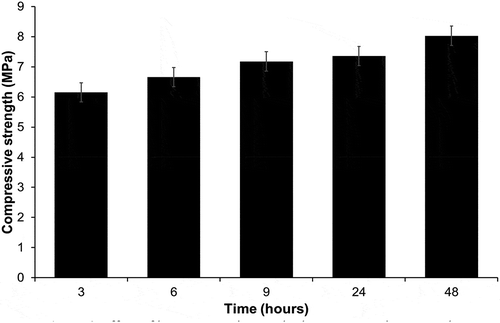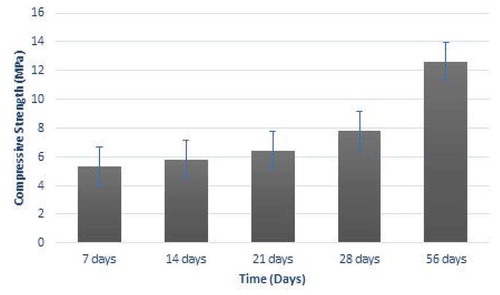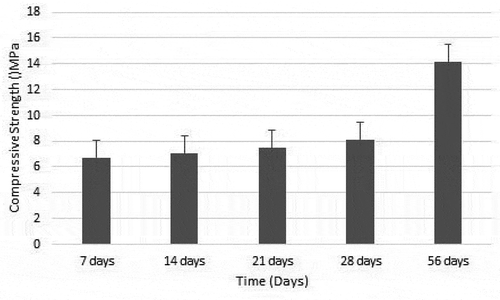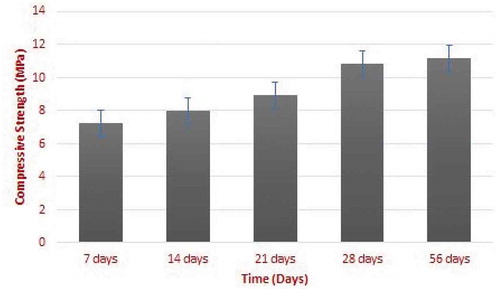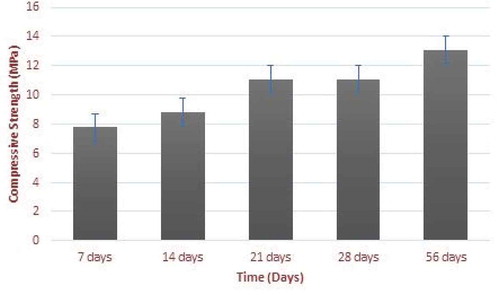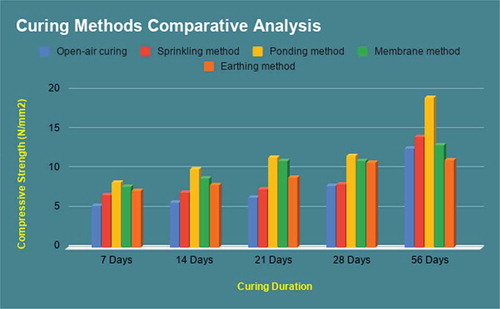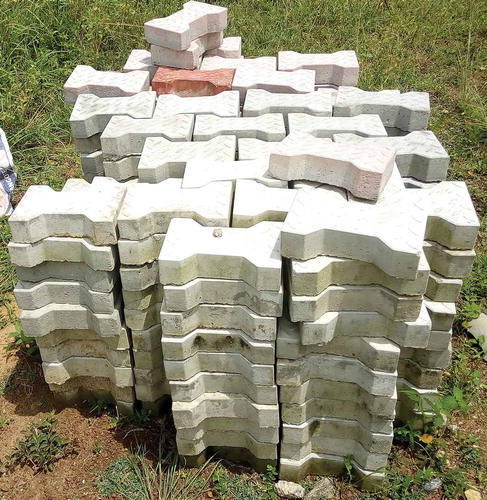Abstract
Interlocking paving blocks (IPB) are an integral part of the pavement infrastructure in developing countries. However, the effect of curing methods on the performance of IPB is vague, and the understanding of this phenomenon will ensure optimum strength and performance for subsequent IPB to be produced. Therefore, this study was carried out to investigate the effect of different curing methods on the compressive strength of IPB. The curing methods evaluated are hot water, open-air, ponding, membrane, earthing and sprinkling methods. Dog-bone samples with a cross-sectional area of 24,401 mm2 were designed and made. The samples are cured using different methods and tested at 7, 14, 21, 28 and 56 days except for those cured in hot water which are tested at 3, 6, 9, 24 and 48 hours after casting. Results from this study indicate that the curing method strongly affects the compressive strength of the IPB. The optimum curing method was found to be the ponding method as it resulted in the highest compressive strength.
PUBLIC INTEREST STATEMENT
One of the most used construction elements in recent times is the Interlocking Paving Blocks. Interlocks as been referred to in some environment are used in buildings and road pavement construction. They are made in different shapes and colors to suit the interest of the user. Interlocking paving blocks are molded with the use of cement and granite dusts. The production process is completed with curing which is providing adequate moisture, temperature, and time to allow the concrete to achieve the desired properties for its intended use. The curing however does not follow standard curing methods in most places. In Nigeria for example, Interlocks are placed in open-air with no wetting pattern, they are made to undergo diverse weather conditions (rain and hot sun inclusive) for days before been used. This article compared the usual on-site method (open-air) to other standard curing methods so as to know the best way to achieve maximum strength of the blocks.
1. Introduction
Concrete is a preferred choice of various construction applications ranging from the construction of low performance structures to those with ultra-high performance. The resulting performance of concrete mixtures is dependent on its composition such as the binder, aggregate, water content, etc (Atoyebi et al., Citation2018a; Gana et al., Citation2020; Panda & Ghosh, Citation2002). One of the important low strength concrete composite used mostly in developing countries is interlocking paving blocks (IPB). IPB are known for their peculiarity design, for immaculate finesse, and strength obtained from the use of fine and high-quality materials that can withstand the toughest grind daily. Interlocking tile is a type of floor finishing designed as flat, smooth, single lap and in a manner that their edges mechanically fit with one another to provide a weather seal (Enohuean & Omo-Irabor, Citation2015). IPB are majorly used for roads, parking lots and walkways. The curing method concrete composites are subjected to affects the performance of concrete composites (Olumoyewa D Atoyebi et al., Citation2018b; Zeyad, Citation2019). Therefore, it is paramount to ensure when low-strength composites such as IPB are made; they are cured properly to achieve optimum performance, adequate curing of concrete generally enhances compressive strength. The importance of curing cannot be overemphasized for concrete to be able to actualize desired durability and strength (O D Atoyebi et al., Citation2019; Ramamurthy & Narayanan, Citation2000; Xue et al., Citation2015). The idea behind curing is to maintain the concrete as nearly wet or saturated during cement hydration (Al-Gahtani, Citation2010). Most of the IPB manufacturers in developing countries subject their tiles to random and adverse weather conditions in a quest to cure the IPB after casting. There are six common techniques of curing typically used for curing concrete. These techniques range from water ponding, sprinkling, the use of wet coverings, membrane method, to open-airs curing (Huang et al., Citation2018; Nguyen et al., Citation2019; Zahid et al., Citation2018). However, as there is no comprehensive study that investigates the effect of these curing methods on the performance of IPB, hence, the objective of this study. The compressive strength of IPB should be paramount when being considered for various pavement constructions. Several studies have explored the effect of curing methods on the compressive strength of conventional concrete usually in cubic or cylindrical forms (Brožovský et al., Citation2005; Jiang et al., Citation2015; López Gayarre et al., Citation2014). The studies concluded that the efficiency of curing primarily depends on the kind of curing, type of sample cured, curing time, environmental and storage conditions. Studies have also revealed that curing in open-air results in lower strength compared to indoor curing methods (ACI-305.1-06, Citation2007; Bushlaibi & Alshamsi, Citation2002; Ibrahim et al., Citation2013; Nassif et al., Citation2005; Ozer & Ozkul, Citation2004). However, the effect of these curing methods on the performance of IPB is non-existent. Therefore, this study was carried out to investigate the effect of various curing methods on the compressive strength of IPB. The curing methods investigated in this study is comprised of both indoor and outdoor curing methods and they are hot water, open-air, ponding, membrane, earthing and sprinkling methods. The compressive strength of the IPB subjected to various curing conditions at different ages was investigated and adequately discussed. It is anticipated that the results from this study will be a good resource and reference for contractors and engineers working with IPB
2. Experimental program
2.1. Materials
Portland cement was used as the binder in this study conforming to (BS EN 197-1, Citation2011). Quarry dust (i.e. stone dust) with a maximum particle size of 4.75 mm alongside gravel with a maximum aggregate size of 19 mm was used as aggregate (BS 882, Citation1992). For all mixtures, potable water was used as the mixing solution (BS EN 1008, Citation2002).
3. Experimental methods
As the main objective of this study is to investigate the effect of curing methods, a constant mixture composition with mix ratio 1:4 (cement: quarry dust) was used for all samples. Immediately after mixing, the fresh mixtures were placed in pre-oiled steel molds (Figure ) for easy removal of blocks after setting. All samples were demolded after approximately 24 hours and subjected to various curing conditions. The curing methods evaluated are steam curing, hot water, open-air, ponding membrane, earthing and sprinkling.
Samples cured in hot water were placed in a container filled with water and heated and maintained at a temperature between 80–100°C for the whole duration of curing (i.e. 48 hours). For the open-air curing method, the produced IPB were arranged and left under atmospheric temperature. In membrane curing, the interlocking stones were placed under room temperature and carefully covered with polythene sheets to ensure no loss of moisture from the samples. The ponding method of curing was done by putting the demolded samples in a curing tank that was filled with water. For the sprinkling method, IPB samples were arranged under ambient conditions and water was sprinkled on them twice a day until the testing age. For the earthing curing method, IPB samples were buried 1.0 m beneath the soil and removed at designated testing ages. Except for samples cured in hot water, the compressive strength of the sample was carried out at 7, 28 and 56 days in accordance with test procedures in BS1881-116 (Citation1983). For samples cured in hot water, the compressive strength was evaluated at 3, 6, 9, 24 and 48 hours after soaking in hot water. All the IPB samples were tested at a loading rate of 25 KPa/sec using a 2000KN capacity compressive testing machine. The compressive strength results provided in this study represent the average compressive strength of three samples tested for each curing age and curing method.
4. Results and discussion
4.1. Effect of hot water curing method
The effect of hot water curing on the resulting compressive strength of the IPB at a different time is presented in Figure . It can be observed from the figure that the compressive strength of the IPB increases with age. This increase in the compressive strength can be attributed to the continuous hydration reaction of the cement which leads to the formation of more products and a corresponding increase in strength. For example, the compressive strength after 48 hours of curing in hot water is 23.4% and 8.34% higher than the compressive strength observed at 3 and 24 hours respectively. It can also be observed that the 3 hours strength is about 76.6% of the compressive strength observed at 48 hours. These results show that the hot water curing method can be used to achieve higher early age strength before subjecting IPB to other types of curing methods. Extensive curing hot water curing up to 48 hours can be employed when higher early strength is required, and no further curing method will be used for IPB. This curing technique is also viable in constructions where long-time curing cannot be achieved. A similar observation has been reported by (Chithra & Dhinakaran, Citation2014) where they observed rapid strength gain of concrete mixtures cured in water for about 6 hours.
4.2. Effect of open-air curing method
As the name implies, IPB samples subjected to this temperature are cured in the open air after demolding. The compressive strength of the IPB subjected to open-air curing is presented in Figure . It can be observed that similar to the IPB samples cured in hot water, the compressive strength of the samples increased with age. The 56th-day compressive strength of IPB cured in the open air is 54% and 32.4% higher than the compressive strength at 7 and 28 days respectively. The increase in the compressive strength of the mixture can also be attributed to the continuous formation of hydration products. The low strength observed on the 7 days (i.e. 5.35MPa) might not make the IPB cured in open-air suitable in certain applications where higher early strength is required. Nevertheless, the possible use of hot water curing and open-air curing can be used to enhance both the early and later age compressive strength of IPB.
4.3. Effect of sprinkling curing method
The average compressive strength of IPB samples cured using the sprinkling method is presented in Figure . The mean compressive strength from the sprinkling method of curing varied from 6.68 MPa (7 days) to 12.12 MPa (56 days) as shown in Figure .
4.4. Effect of earthing curing method
The compressive strength of IPB samples subjected to earthing curing method is presented in Figure . It can be observed from the figure that in contrast to other curing methods, the compressive strength at 28 days and 56 days is approximately the same. The compressive strength at 28 days is 10.8MPa while that at 56 days is 13.2MPa. Nonetheless, the compressive strength at these later ages is higher than that at 7 days. For example, the compressive strength at 28 days is 33.1% higher than that at 7 days. These results showed that this method is only effective for strength gain up to 28 days.
4.5. Effect of ponding curing
The compressive strength observed for IPB samples cured by ponding is presented in Figure . It can be observed from Figure that similar to other curing methods, the compressive strength increased with age. However, the compressive strength observed for this curing method is higher than other methods and the compressive strength increased significantly between ages. For example, the compressive strength at 28 and 56 days is 28.6% and 56.4% higher than the compressive strength at 7 days. This result indicates this method is effective when a higher later age is required and long-term curing possible. The higher compressive strength observed in this method in contrast to other methods has also been reported by Zeyad (Citation2019) where they reported higher performance in concrete samples cured using the ponding method.
4.6. Effect of membrane curing method
Curing by membrane method was achieve by covering the surface of the samples with a polythene membrane immediately after demolding. The resulting average compressive strength of the samples subjected to this curing method is presented in Figure . Compressive strength as high as 14.4MPa was achieved at 56 days while that at 7 days is approximately half of the 56th day compressive strength (i.e. 7.8MPa).
4.7. Comparative analysis of curing methods
The compressive strength of IPB cured using curing methods except for hot water curing is presented in Figure . Comparing the compressive strength achieved using different curing methods at 7 days, it can be observed that those cured using the ponding method is the highest. The 7-day compressive strength of samples cured using the ponding method is 35.8%, 19.7% and 6.37% higher than those cured in open-air, sprinkling and membrane respectively (Table ). It can be observed that the compressive strength of samples cured using the membrane method is closer to that of the ponding method. The higher compressive strength of membrane method when compared to the open-air and sprinkling method can be attributed to less water content lost to the atmosphere during curing. Therefore, the membrane method is suitable in applications where ponding methods are not possible or economical. Similar to the 7-day compressive strength, the use of ponding method for curing resulted in higher compressive strength at 56 days. Nevertheless, the use of sprinkling and membrane method gave higher compressive strength than the open and earthing method. The membrane method is 3.7% and 14.8% higher than the open-air and earthing curing method. Therefore, depending on resources available, the use of ponding, sprinkling and membrane method are suggested. Nonetheless, for proper curing of IPB for pavement usage, a long period of curing is ideal and should be utilized as much strength would be gained for the appropriate usage. However, in areas where water is scarce, the membrane method can be adopted as much compressive strength can be derived through it. More so, the earthing method can be considered in some cases, however; where neat IPB are required, such cannot be obtained as stains were observed on IPB cured using this method, and any attempt to remove the stains will require a lot of work. The low compressive strength constantly obtained using open-air curing might be due to the exposure of the tiles to different weather conditions during the curing stage. Based on the usage of ponding method for curing of tiles can be recommended as better compressive strength can be obtained as the number of curing days increases.
Table 1. Mean compressive strength comparison for different curing methods
5. Conclusions
This study has evaluated the effect of different curing methods on the compressive strength of interlocking paving blocks. Based on the experimental test results obtained in this study, the following conclusions can be drawn:
Ponding technique is the best curing technique with the highest compressive strength. The total submersion in water makes the blocks durable and gives high strength. In terms of maintenance cost also, the ponding method of curing is the best method of all the methods used. However, in places where there is an inadequate water supply, the membrane method can be adopted, the membrane method is a better alternative that could be adopted for better compressive strength of the concrete tiles.
Earthing method gave the third highest values for compressive strength although permanent stains obtained from the earth would be left on the interlocking stones and would require a lot of work to bring them out and keep them clean.
Hot water curing, on the other hand, has shown to be effective when early strength is desired a few hours after demolding. Results from this study showed that the compressive strength of about 8MPa can be achieved 48 hours after demolding. This compressive strength achieved within 48 hours after demolding was achieved after 7 days for samples cured using the ponding method. Similarly, the compressive strength obtained after 3 hours of hot water curing is higher than that obtained for samples cured in open-air for 7 days.
Generally, it is established that the open-air method of curing which entails leaving the produced IPB under various weather conditions is not encouraged at all as it gave the lowest compressive strength compared to other curing methods. Hence, for adequate strength for IPS, curing should be done effectively.
Acknowledgements
The authors would like to acknowledge Engr. Oluwasegun Aladegboye of the Geotechnics Laboratory, Department of Civil Engineering, Landmark University, Omu-Aran Nigeria for his support all through the research work.
Additional information
Funding
Notes on contributors
O. D. Atoyebi
Atoyebi, Olumoyewa Dotun is a Lecturer in the Department of Civil Engineering at LANDMARK University, Omuaran. Kwara State. He has his First degree in Civil Engineering (Ladoke Akintola University of Technology, Ogbomoso, Nigeria) and a Second degree in Civil Engineering (Structures Option, University of Lagos, Nigeria). He is a Registered Engineer with over five years’ experience in Civil Engineering Construction and Consultancy. As an Engineer, he has supervised various constructions like Building projects, Road Constructions, Taxiway etc for various Construction firms and Boundary Pillars under the United Nations Boundary Pillar Emplacement for Cameroon-Nigeria Mixed Commission. This experience makes his teaching skills great in Structures Option of Civil Engineering. His research interest focuses on Structural Reliability Theory, Structural Health Monitoring, Structural Dynamics and Construction Materials. He is a member of the Nigeria Society of Engineers (NSE) and a Registered Engineer with the Council for the Regulation of Engineering in Nigeria (COREN).
References
- ACI-305.1-06. (2007). Specification for hot weather concreting. Farmington Hills.
- Al-Gahtani, A. S. (2010). Effect of curing methods on the properties of plain and blended cement concretes. Construction and Building Materials, 24(3), 308–11. https://doi.org/10.1016/j.conbuildmat.2009.08.036
- Atoyebi, O. D., Ayanrinde, O. P., & Oluwafemi, J. (2019). Reliability comparison of schmidt rebound hammer as a non-destructive test with compressive strength tests for different concrete mix. Journal of Physics: Conference Series, 1378 (3), 1-.9. https://doi.org/10.1088/1742-6596/1378/3/032096
- Atoyebi, O. D., & Odeyemi, O. J., S. V. A. (2018a). Evaluation of laterized earth moist concrete in construction works. International Journal of Civil Engineering and Technology, 9 (10), 327–333. http://www.iaeme.com/ijciet/issues.asp?JType=IJCIET&VType=9&IType=10
- Atoyebi, O. D., Odeyemi, S. O., Bello, S. A., & Ogbeifun, C. O. (2018b). Splitting tensile strength assessment of lightweight foamed concrete reinforced with waste tyre steel fibres. International Journal of Civil Engineering and Technology, 9(9), 1129–1137.
- Brožovský, J., Matejka, O., & Martinec, P. (2005). Concrete interlocking paving blocks compressive strength determination using non-destructive methods. In The 8th international conference of the slovenian society for non-destructive testing. (pp. 91–97). Portoroz, Slovenia.
- BS 882. (1992). BS 882: 1992.specification for aggregates from natural sources for concrete. British Standard Institute.
- BS EN 1008. (2002). BS EN 1008: 2002Mixing water for concrete. Specification for sampling, testing and assessing the suitability of water, including water recovered from processes in the concrete industry, as mixing water for concrete. British Standard Institute.
- BS EN 197-1. (2011). BS EN 197-1:2011. Cement, composition, specifications and conformity criteria for common Cements. British Standard Institute.
- BS1881-116. (1983). BS 1881 part 116-1983. Testing concrete: Method for determination of compressive strength of cubes. British Standard Institute.
- Bushlaibi, A. H., & Alshamsi, A. M. (2002). Efficiency of curing on partially exposed high-strength concrete in hot climate. Cement and Concrete Research, 32(6), 949–953. https://doi.org/10.1016/S0008-8846(02)00735-4
- Chithra, S., & Dhinakaran, G. (2014). Effect of hot water curing and hot air oven curing on admixed concrete. International Journal of ChemTech Research, 6(2), 1516–1523. http://sphinxsai.com/2014/CTVOL6/CT=79(1516-1523)AJ14.pdf
- Enohuean, M. N., & Omo-Irabor, I. E. (2015). Students’ work experience programme: terrazzo flooring and moulding of interlocking tiles. Journal of Advancement in Engineering Technology, 2(2), 1–5. https://doi.org/10.15297/JAET.V2I3.02
- Gana, A. J., Atoyebi, O. D., & Ichagba, R. B. (2020). Effect of different brands of Nigerian cement on the properties of pervious concrete effect of different brands of Nigerian cement on the properties of pervious concrete. IOP Conference Series: Earth and Environmental Science, 445 (1), 012029. https://doi.org/10.1088/1755-1315/445/1/012029
- Huang, G., Ji, Y., Zhang, L., Li, J., & Hou, Z. (2018). The influence of curing methods on the strength of MSWI bottom ash-based alkali-activated mortars: The role of leaching of OH− and free alkali. Construction and Building Materials, 186 (1), 978–985. https://doi.org/10.1016/j.conbuildmat.2018.07.224
- Ibrahim, M., Shameem, M., Al-mehthel, M., & Maslehuddin, M. (2013). Effect of curing methods on strength and durability of concrete under hot weather conditions. Cement and Concrete Composites, 41 (1), 60–69. https://doi.org/10.1016/j.cemconcomp.2013.04.008
- Jiang, C., Gu, X., Zhang, W., & Zou, W. (2015). Modeling of carbonation in tensile zone of plain concrete beams damaged by cyclic loading. Construction and Building Materials, 77 (1), 479–488. https://doi.org/10.1016/j.conbuildmat.2014.12.088
- López Gayarre, F., López-Colina Pérez, C., Serrano López, M. A., & Domingo Cabo, A. (2014). The effect of curing conditions on the compressive strength of recycled aggregate concrete. Construction and Building Materials, 53 (1), 260–266. https://doi.org/10.1016/j.conbuildmat.2013.11.112
- Nassif, H. H., Najm, H., & Suksawang, N. (2005). Effect of pozzolanic materials and curing methods on the elastic modulus of HPC. Cement and Concrete Composites, 27(6), 661–670. https://doi.org/10.1016/j.cemconcomp.2004.12.005
- Nguyen, H. V., Nakarai, K., Okazaki, A., Karasawa, H., Tadokoro, Y., & Tsujino, M. (2019). Applicability of a simplified estimation method to steam-cured expansive concrete. Cement and Concrete Composites, 95 (1), 217–227. https://doi.org/10.1016/j.cemconcomp.2018.11.002
- Ozer, B., & Ozkul, M. H. (2004). The influence of initial water curing on the strength development of ordinary portland and pozzolanic cement concretes. Cement and Concrete Research, 34(1), 13–18. https://doi.org/10.1016/S0008-8846(03)00185-6
- Panda, B. C., & Ghosh, A. K. (2002). Structural behavior of concrete block paving. II: Concrete blocks. Journal of Transport Engineering, 128(2), 130–135. https://doi.org/10.1061/(ASCE)0733-947X(2002)128:2(130)
- Ramamurthy, K., & Narayanan, N. (2000). Influence of composition and curing on drying shrinkage of aerated concrete. Materials and Structures, 33 (4), 243–250. https://doi.org/10.1007/BF02479334
- Xue, B., Pei, J., Sheng, Y., & Li, R. (2015). Effect of curing compounds on the properties and microstructure of cement concretes. Construction and Building Materials, 101 (1), 410–416. https://doi.org/10.1016/j.conbuildmat.2015.10.124
- Zahid, M., Shafiq, N., & Jalal, A. (2018). Investigating the effects of solarcure curing method on the compressive strength, microstructure and polymeric reaction of fly ash based geopolymer. Construction and Building Materials, 181 (1), 227–237. https://doi.org/10.1016/j.conbuildmat.2018.06.046
- Zeyad, A. M. (2019). Effect of curing methods in hot weather on the properties of high-strength concretes. Journal of King Saud University - Engineering Sciences, 31(3), 218–223. https://doi.org/10.1016/j.jksues.2017.04.004


